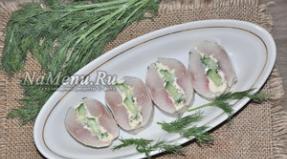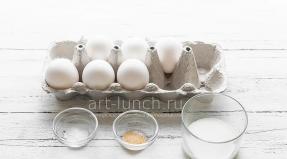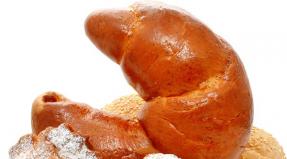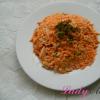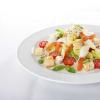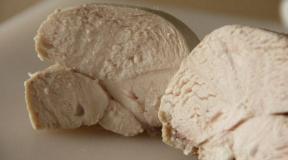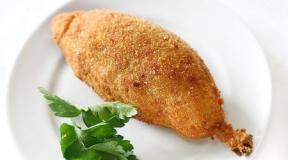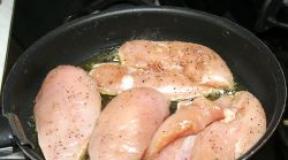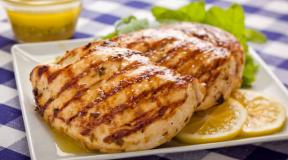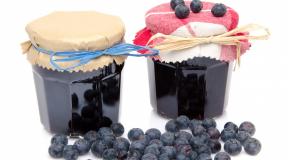How did mayonnaise come about? Who invented mayonnaise and the famous recipe of Provence
There is an opinion that in case of failures in the culinary field, one should not despair too much if there are mayonnaise and ketchup in the refrigerator. After all, with their help, many mistakes can be corrected. How true this statement is is up to you to judge, but there is an indisputable fact: these two sauces are present on dinner tables more than anyone else.
Mayonnaise history
To the question of who invented mayonnaise, there are as many as three possible answers. One thing unites them - the events unfolded in the 18th century.
Bread with mayonnaise - yummy!
The first story tells about the besieged Spanish city of Mahon and gives an answer to the question "in what year mayonnaise was invented", because the actions took place in 1757. At that time, the city was captured by the French under the leadership of the Duke de Richelieu and held the defense against the British. The siege lasted a long time, and the French army faced the problem of starvation, since only two products remained in the arsenal of cooks: olive oil and turkey eggs. No matter how hard the chefs tried to diversify the soldier's menu, they did not succeed well. Then one of the cooks tried to grind the yolks with spices, after which he added olive oil in small doses. The result was an excellent sauce, with which even ordinary bread became an elegant delicacy for warriors. Unfortunately, the one who invented mayonnaise did not leave his name in history. Therefore, the sauce was named not in honor of the culinary specialist, but in honor of the besieged city - Mahon, later - just mayonnaise.
Special table decoration
The second story gives a slightly different answer to the question of who invented mayonnaise, but takes us all to the same city of Mahon, but 25 years later. By that time, the Spaniards had captured it. In honor of the victory, the leader of the army, Duke Louis de Crillon, ordered a magnificent celebration. The task for the chefs now was not to come up with something out of nothing, but on the contrary - to provide the table with a twist, a special dish that everyone would remember. In response to his demand, the cooks mixed olive oil with yolks and lemon juice, seasoned with sugar, salt and red pepper. So it turned out an exquisite Provencal sauce.

This version of who invented mayonnaise is very doubtful and contradictory. Agree, it’s quite difficult on the go, being under the pressure of following an order, to come up with such an original dish without knowing its basic principle. Therefore, there is another story about who invented mayonnaise.
The progenitor of mayonnaise - ali-oli sauce
This version is not related to the Spanish city. According to her, the place where mayonnaise was invented was Southern Europe. Long before the events in Mahon, local residents prepared a spicy mixture of eggs, butter and garlic. They called it "ali-oli", which in Spanish means "oil and garlic." Of course, this garlic sauce is significantly different from the usual mayonnaise, but French chefs could know the principle and successfully use it as a special dish on the ceremonial table. Today, the mass of garlic is known as

Comparing all three stories, we can draw the only correct conclusions - mayonnaise, in a familiar form in our time, was invented by the French in the 18th century. Until then, no one knew about him. Needless to say, after the appearance of white sauce, the recipe for its preparation was kept in strict confidence. Because without knowledge of special technical secrets, it is impossible to prepare mayonnaise. Accordingly, the price for this product was quite high.
The famous Olivier
In the 19th century, French-born culinary specialist Lucien Olivier opened the Hermitage restaurant in Moscow. Monsieur came from a well-known French dynasty of chefs who contributed to the preparation of maon sauce. In particular, they began to add mustard to it. This little nuance greatly simplified the cooking process and extended the shelf life, since mustard is a natural emulsifier. Due to the piquant spicy taste, the sauce was given its own name - "Provencal", or Provencal.

The owner of mayonnaise secrets Lucien Olivier made a great contribution to the development of the traditions of Russian cuisine. His most famous invention was a winter salad, which was later given the name of the chef - Olivier. It is difficult to imagine the Russian New Year even in the 21st century without this salad on the table. During its formation, it has become a real tradition of the nation, although the recipe familiar to every housewife differs significantly from that admired by the inhabitants of Moscow in the 19th century. Unfortunately, the restaurateur Lucien was categorical and kept the secret of cooking under lock and key until his death. No matter how hard the then competitors tried to recreate his creation (after all, almost all the ingredients were known), they did not succeed in repeating the masterpiece exactly. The original recipe went with its author to the grave.
Tomato sauce
In addition to mayonnaise, there is another sauce no less known to everyone. If to some extent we have answered the question of who invented mayonnaise, things are somewhat different with ketchup. The most likely version is that it was brought to Europe in the 17th century by British sailors who came from China. True, the then ketchup did not much resemble the tomato mixture that is popular today. It included anchovies, mushrooms, spices, soybeans, but tomatoes were not even close to the ingredients necessary for cooking. Tomatoes began to be added to the composition only in 1830.

The most popular ketchup has become in the United States. Americans still treat this sauce in a special way. Statistics show that almost 97% of the inhabitants of this country can not do without ketchup at the dinner table. They add it to almost every possible dish.
Ketchup gained fame due to the content of a powerful antioxidant lycopene in tomatoes, which is able to fight free radicals, which means it prolongs youth. In addition, its constant use can prevent the occurrence of cancer. Studies have shown that lycopene is better absorbed by the body not in its raw form, but in processed form. This is why Americans prefer ketchup over fresh tomatoes.
Any dish is most healthy and tasty when it is prepared from quality products and immediately served fresh to the table. Mayonnaise and ketchup are no exception to this rule. Today, on various culinary portals, you can find a large number of recipes for preparing these sauces, which will help to harmoniously emphasize the tastes of many dishes, both festive and everyday feasts.
, sugar , table salt , sometimes mustard and other spices .
Story
The origin of the word "mayonnaise" in French is unknown. Larousse Gastronomique 1961 is of the opinion that the word comes from the old French "moyeu", which, among other things, meant yolk.
There are other versions of its origin, mostly legendary and based on vivid historical events. Here is one of them:
The word "mayonnaise" is of geographical origin and is associated with the name of the city of Mahon, the capital of the Spanish island of Menorca, which is part of the Balearic Islands. As stated in one of the French encyclopedic dictionaries, Mahon was conquered by the Duke of Richelieu. In 1758, the British laid siege to this city. The French ran out of food except for eggs and olive oil. From these products, the cooks prepared scrambled eggs and omelettes, which the French officers were pretty tired of. Duke Richelieu ordered his cook to prepare some new dish. The resourceful cook beat the eggs with butter and seasoned the mixture with salt and spices. The sauce they liked was called "mayonnaise", in honor of the city of Mahon.
In Menorca itself, mayonnaise is called salsa mahonesa (Maon sauce).
It is possible that this simple sauce is quite ancient and originated independently in several places in the Mediterranean - where there is olive oil and eggs.
There is another version that mayonnaise originated from ali-oli sauce (garlic grated with olive oil), known since time immemorial.
Traditional composition
The original mayonnaise recipe consists of egg yolk, vinegar, vegetable oil, salt, and pepper (a spice). You can add various ingredients for flavor - lemon, mustard, which improves the elasticity of the emulsion. In Germany and the Netherlands, mayonnaise is traditionally sweetened slightly.
For Russia and the CIS countries, sunflower oil and mustard oil are often used as the main ingredients. In other countries, olive oil and pureed mustard are very often used.
Mayonnaise industrial production
Industrially produced mayonnaise follows a conventional recipe, but uses refined oils and milk and eggs in the form of egg powder and milk powder. Purification of oils by refining and eggs and milk by pasteurization is carried out to destroy bacteria and viruses to increase the shelf life of mayonnaise, as well as reduce the risk of food poisoning to consumers, both from spoilage of the mayonnaise itself and from spoilage of products for its production during storage.
Classification
In the Soviet Union, Provencal mayonnaise, produced at many oil and fat plants, was traditionally popular. The recipe and composition of mayonnaise was strictly regulated by the state standard. Mayonnaise was made from traditional products: sunflower oil, water, egg powder, milk powder, salt, sugar, mustard powder, vinegar - and had a fat content of 67%. The only preservative in Provence mayonnaise was spirit vinegar.
In Russia, standards in the food industry, including standards for mayonnaise, have been significantly liberalized. GOST 30004.1-93 gave greater freedom in the choice of composition and the use of chemical additives. But manufacturers are in no hurry to follow even him, inventing their own specifications. According to GOST 30004.1-93, all ready-made "mayonnaises", depending on their fat content, were divided into classes:
- high-calorie (mass fraction of fat from 55%; water less than 35%)
- medium-calorie (mass fraction of fat 40-55%; water 30-50%)
- low-calorie (mass fraction of fat up to 40%; water more than 50%)
On July 1, 2012, GOST R 53590-2009 came into force, which significantly tightens the quality requirements for mayonnaise. According to the new GOST, only a product containing at least 50% fat and 1% egg powder can be called mayonnaise. Products with a fat content of at least 15% may be referred to as "mayonnaise sauce".
Technology
Mayonnaise is a water-in-oil emulsion and has traditionally been made with egg lecithin (egg yolk). Later, it was almost completely replaced by soy lecithin and other emulsifiers with HLB 8...18.
Best before date
The original mayonnaise is stored for only a few days, as its recipe includes perishable products. To increase the shelf life, manufacturers use preservatives, refining and pasteurization of components. The shelf life of mayonnaises of different brands ranges from 1 to 7 months.
Effect on the body
Mayonnaise is a flavoring seasoning for food.
Mayonnaise, along with ketchup, kvass, mushrooms, okroshka, naval pasta and fried eggs, is prohibited for meals in schools, primary and secondary vocational education institutions in Russia.
Well-known nutritionist, doctor of medical sciences, M.M. Ginsburg notes that the harm of mayonnaise is mostly a philistine myth and it is not mayonnaise itself that affects health badly, but an imbalance in fat intake and, above all, excessive calorie intake.
Mayonnaise itself consists of 60-80% vegetable sunflower oil, which, unlike animal fats or palm oil, does not lead to the formation of excess cholesterol, i.e. in the balance of fat consumption are one of the safest. Egg powder and milk powder in mayonnaise are not more dangerous to health than eggs and milk. Mustard oil as part of mayonnaise is a very useful product due to omega-3 fats that destroy cholesterol, and mustard oil is one of the most effective means for generating endorphin, the "happiness hormone", which explains the burst of energy that appears after eating mayonnaise and cravings for it.
It should be borne in mind that although the main ingredient of mayonnaise as sunflower oil does not contain cholesterol, nevertheless eggs in the form of a powder or natural mayonnaise contain a lot of cholesterol. According to the USDA, regular mayonnaise has 42 mg of cholesterol per 100 grams. For comparison, according to the USDA in eggs - 373 mg, in butter - 215 mg, and meat - 73 mg per 100 grams. It is sometimes pointed out that cholesterol is destroyed during frying, and salads with mayonnaise are usually served without heat treatment, so mayonnaise is a great source of cholesterol. Meanwhile, this is not true, because. cholesterol crystals do not even melt up to +148 C, and cholesterol is destroyed only at +360 C. In addition, it should be borne in mind that egg powder in the composition of industrial mayonnaise also undergoes pasteurization at high temperatures.
Since the industrial production of mayonnaise uses purified (refined) oils, as well as egg and milk powders pasteurized at high temperature, almost 100% destruction of bacteria and viruses occurs, which explains the long shelf life of industrially produced mayonnaise and the extremely low risk of food poisoning. During the refining of oils used for industrial mayonnaises, oxidizers that cause food spoilage are destroyed as free fatty acids. Pasteurization of egg powder renders Salmonella infection impossible. True, it should be taken into account that refining and pasteurization also reduce the amount of vitamins and phosphorus-containing substances. When making mayonnaise according to "homemade recipes" from natural oils, eggs and milk, more useful substances are preserved, but the risk of poisoning from food spoilage or infection when they are infected with bacteria or viruses increases.
The danger of mayonnaise for health lies in its very high calorie content of 680 kcal per 100 grams due to the large amount of vegetable fats. At the same time, the calorie content of mayonnaise according to the USDA is lower than sunflower oil 884 kcal with the same salad dressing. This is due to the fact that mayonnaise is a water-in-oil emulsion, i.e. sunflower oil is diluted with water, so the calorie content is less. At the same time, there are also low-calorie mayonnaises with an even lower calorie content. Therefore, the higher calorie content of mayonnaise relative to salad dressing oil is another myth.
see also
Write a review on the article "Mayonnaise"
Notes
Links
- . Mayonnaises and mayonnaise sauces. General specifications
|
||||||||||||||||||||||||||
An excerpt characterizing Mayonnaise
Iogel had the funniest balls in Moscow. This was said by mothers, looking at their adolescentes, [girls] doing their newly learned steps; this was said by the adolescentes and adolescents themselves, [girls and boys] dancing until they dropped; these grown girls and young people who came to these balls with the idea of descending to them and finding the best fun in them. In the same year, two marriages took place at these balls. Two pretty princesses Gorchakovs found suitors and got married, and all the more they let these balls into glory. What was special at these balls was that there was no host and hostess: there was, like fluff flying, bowing according to the rules of art, good-natured Yogel, who accepted tickets for lessons from all his guests; was that only those who wanted to dance and have fun, as 13 and 14 year old girls who put on long dresses for the first time, still went to these balls. All, with rare exceptions, were or seemed pretty: they all smiled so enthusiastically and their eyes lit up so much. Sometimes the best students even danced pas de chale, of which the best was Natasha, distinguished by her grace; but at this, the last ball, only ecossaises, anglaises and the mazurka, which was just coming into fashion, danced. The hall was taken by Yogel to Bezukhov's house, and the ball was a great success, as everyone said. There were many pretty girls, and the Rostov young ladies were among the best. Both of them were especially happy and cheerful. That evening, Sonya, proud of Dolokhov's proposal, her refusal and explanation with Nikolai, was still circling at home, not allowing the girl to comb her braids, and now shone through with impetuous joy.Natasha, no less proud that she was in a long dress for the first time, at a real ball, was even happier. Both were in white, muslin dresses with pink ribbons.
Natasha became in love from the very moment she entered the ball. She was not in love with anyone in particular, but she was in love with everyone. In the one she looked at at the moment she looked, she was in love with him.
- Oh, how good! she kept saying, running up to Sonya.
Nikolai and Denisov walked through the halls, looking affectionately and patronizingly at the dancers.
- How sweet she is, she will be, - said Denisov.
- Who?
“Mr. Athena Natasha,” answered Denisov.
- And how she dances, what a g "ation!" After a pause, he said again.
- Who are you talking about?
“About your sister,” Denisov shouted angrily.
Rostov chuckled.
– Mon cher comte; vous etes l "un de mes meilleurs ecoliers, il faut que vous dansiez," said little Yogel, approaching Nikolai. "Voyez combien de jolies demoiselles. [Dear count, you are one of my best students. You need to dance. See how much pretty girls!] - He turned with the same request to Denisov, also his former student.
- Non, mon cher, je fe "ai tapisse" ie, [No, my dear, I'll sit by the wall,] said Denisov. "Don't you remember how badly I used your lessons?"
- Oh no! – hastily comforting him, said Yogel. - You were only inattentive, but you had the ability, yes, you had the ability.
The newly introduced mazurka began to play; Nikolai could not refuse Yogel and invited Sonya. Denisov sat down next to the old women and leaned on his saber, stomping to the beat, telling something merrily and making the old ladies laugh, looking at the dancing youth. Yogel in the first pair danced with Natasha, his pride and best student. Softly, gently moving his feet in his shoes, Yogel was the first to fly across the hall with Natasha, who was timid, but diligently doing her steps. Denisov did not take his eyes off her and tapped time with his saber, with an air that clearly said that he himself did not dance only because he did not want to, and not because he could not. In the middle of the figure, he called to him Rostov, who was passing by.
“That's not it at all,” he said. - Is this a Polish mazu "ka? And she dances well." Knowing that Denisov was even famous in Poland for his skill in dancing the Polish mazurka, Nikolai ran up to Natasha:
- Go ahead, choose Denisov. Here she is dancing! Miracle! - he said.
When it was Natasha's turn again, she stood up and quickly fingering her shoes with bows, timidly, ran alone through the hall to the corner where Denisov was sitting. She saw that everyone was looking at her and waiting. Nikolai saw that Denisov and Natasha were arguing with a smile, and that Denisov refused, but smiled happily. He ran.
“Please, Vasily Dmitritch,” Natasha said, “let’s go, please.”
“Yes, thank you, Mrs. Athena,” said Denisov.
“Well, that’s enough, Vasya,” said Nikolai.
“It’s like Vaska is being persuaded,” Denisov said jokingly.
“I will sing to you all evening,” said Natasha.
- The sorceress will do everything with me! - said Denisov and unfastened his saber. He stepped out from behind the chairs, firmly took his lady by the hand, raised his head and put his foot aside, expecting tact. Only on horseback and in a mazurka was Denisov's small stature not visible, and he seemed to be the same fine fellow as he himself felt. After waiting for a beat, he looked at his lady from the side, victoriously and jokingly, unexpectedly tapped with one foot and, like a ball, rebounded resiliently from the floor and flew along in a circle, dragging his lady with him. He silently flew half the hall on one leg, and seemed not to see the chairs standing in front of him and rushed straight at them; but suddenly, snapping his spurs and spreading his legs, he stopped on his heels, stood like that for a second, with a clatter of spurs, his feet tapped in one place, quickly turned around and, snapping his left foot with his right, again flew in a circle. Natasha guessed what he intended to do, and, not knowing how herself, followed him - surrendering to him. Now he circled her, then on his right, then on his left hand, then falling to his knees, circled her around him, and again jumped up and rushed forward with such swiftness, as if he intended, without taking a breath, to run across all the rooms; then he would suddenly stop again and make another new and unexpected knee. When he, briskly circling the lady in front of her seat, clicked his spur, bowing in front of her, Natasha did not even sit down to him. She fixed her eyes on him in bewilderment, smiling as if she did not recognize him. – What is it? she said.
Despite the fact that Yogel did not recognize this mazurka as real, everyone was delighted with the skill of Denisov, they incessantly began to choose him, and the old people, smiling, began to talk about Poland and about the good old days. Denisov, flushed from the mazurka and wiping himself with a handkerchief, sat down next to Natasha and did not leave her the whole ball.
Two days after this, Rostov did not see Dolokhov at his home and did not find him at home; on the third day he received a note from him. “Since I no longer intend to visit your house for reasons known to you and I am going to the army, this evening I give my friends a farewell feast - come to an English hotel.” Rostov at 10 o'clock, from the theater, where he was with his friends and Denisov, arrived on the appointed day at the English hotel. He was immediately taken to the best room in the hotel, occupied by Dolokhov that night. About twenty people crowded around the table, in front of which Dolokhov sat between two candles. Gold and banknotes lay on the table, and Dolokhov threw the bank. After the proposal and refusal of Sonya, Nikolai had not yet seen him and was confused at the thought of how they would meet.
Dolokhov's bright, cold gaze met Rostov at the door, as if he had been waiting for him for a long time.
“Long time no see,” he said, “thank you for coming.” That's just home, and Ilyushka will appear with the choir.
“I stopped by to see you,” Rostov said, blushing.
Dolokhov did not answer him. “You can bet,” he said.
Rostov remembered at that moment a strange conversation he had once had with Dolokhov. “Only fools can play for luck,” Dolokhov said then.
Or are you afraid to play with me? Dolokhov said now, as if he had guessed Rostov's thought, and smiled. Because of his smile, Rostov saw in him the mood of the spirit that he had during dinner at the club and in general at those times when, as if bored with everyday life, Dolokhov felt the need to get out of it by some strange, mostly cruel act. .
Rostov felt uncomfortable; he searched and did not find in his mind a joke that would answer Dolokhov's words. But before he could do this, Dolokhov, looking straight into Rostov's face, slowly and deliberately, so that everyone could hear, said to him:
- Do you remember, we talked about the game with you ... a fool who wants to play for luck; I should probably play, but I want to try.
"Try for luck, or perhaps?" thought Rostov.
“Besides, don’t play,” he added, and cracking a torn deck, he added: “A bank, gentlemen!
Pushing the money forward, Dolokhov prepared to throw. Rostov sat down beside him and at first did not play. Dolokhov looked at him.
Why don't you play? Dolokhov said. And strangely, Nikolai felt the need to take a card, put a small sum on it and start the game.
“I don’t have any money with me,” Rostov said.
- I believe!
Rostov put 5 rubles on the card and lost, put another and lost again. Dolokhov killed, that is, he won ten cards in a row from Rostov.
“Gentlemen,” he said after a few moments, “please put money on cards, otherwise I might get confused in the accounts.”
One of the players said that he hoped he could be trusted.
- You can believe, but I'm afraid to get confused; I ask you to put money on cards, - Dolokhov answered. "Don't be shy, we'll deal with you," he added to Rostov.
The game went on: the footman, without ceasing, served champagne.
All the cards of Rostov were beaten, and up to 800 tons of rubles were written on it. He was about to write 800 tons of rubles over one card, but while he was being served champagne, he changed his mind and wrote again an ordinary kush, twenty rubles.
- Leave it, - said Dolokhov, although he did not seem to be looking at Rostov, - you will soon win back. I give to others, but I beat you. Or are you afraid of me? he repeated.
Rostov obeyed, left the written 800 and placed a seven of hearts with a corner torn off, which he picked up from the ground. He remembered her well afterwards. He placed the seven of hearts, writing 800 above it in broken off chalk, in round, straight numbers; drank the served glass of warmed champagne, smiled at Dolokhov's words, and with bated breath, waiting for the seven, began to look at Dolokhov's hands, holding the deck. Winning or losing this seven of hearts meant a lot to Rostov. On Sunday last week, Count Ilya Andreich gave his son 2,000 rubles, and he, who never liked to talk about financial difficulties, told him that this money was the last until May, and that therefore he asked his son to be more economical this time. Nikolai said that this was too much for him, and that he gave his word of honor not to take more money until spring. Now 1,200 rubles remained of this money. Therefore, the seven of hearts meant not only the loss of 1,600 rubles, but also the need to change this word. With bated breath, he looked at Dolokhov’s hands and thought: “Well, hurry up, give me this card, and I’ll take my cap, go home to dinner with Denisov, Natasha and Sonya, and surely there will never be a card in my hands.” At that moment, his home life, jokes with Petya, conversations with Sonya, duets with Natasha, a picket with his father, and even a quiet bed in the Cook's House, presented themselves to him with such force, clarity and charm, as if all this had long passed, lost and invaluable happiness. He could not allow that a stupid accident, forcing the seven to lie first on the right than on the left, could deprive him of all this newly understood, newly illuminated happiness and plunge him into the abyss of an as yet unexperienced and indefinite misfortune. It could not be, but he still waited with bated breath for the movement of Dolokhov's hands. These broad-boned, reddish hands, with hair visible from under their shirts, laid down a deck of cards and took up the glass and pipe being served.
Mayonnaise has firmly entered our lives and, it seems, has always been on our table. It is a dressing for many salads and is present in various dishes. However, the age of mayonnaise is not as respectable as many believe, and in Russia it appeared relatively recently.
There are various legends that describe the origin of this noble sauce. All events related to the history of mayonnaise relate to the tumultuous events that took place in the 18th century.
№1
There was a seven-year war, 1756. French troops landed on the Spanish island of Menorca, which is located in the Mediterranean Sea, and successfully captured its capital, Mahon. In turn, the English army landed on this island and laid siege to the fortress. The siege dragged on, and the French troops, commanded by the Duke of Richelieu, had a hard time, since provisions were practically absent.
The defenders of the fortress had only constant "supplies" of eggs left.
The critical moment came when the monotonous food bored the French. This had a negative effect on the morale of the soldiers. The duke's cook had to show military ingenuity and find a way out. Through his efforts, a new sauce was born, the recipe of which has survived unchanged to our time.
The resourceful chef ground the egg yolks, added salt and sugar to them. He introduced olive oil into the mixture in a thin stream, accompanying the process with intensive mixing. Finally, lemon juice was added to the mass with continuous stirring. Thus was born the sauce with exquisite taste.
Experiments with the use of various products with it led the French to complete delight. The soldiers soared in spirit and were able to successfully repel the attack of the enemies.
In honor of the city of Mahon, the sauce was named Mahon or, consonant with the name in French, mayonnaise. The heroic cook turned out to be a modest person, so his name is forgotten.
№2
The action took place in 1782 in Mahon. At this time, Mahon was conquered by the Spaniards under the command of Duke Louis de Crillon, a Frenchman by nationality.
According to legend, the sauce was invented because of the abundance of food. The duke decided to celebrate the victory and ordered to decorate the table with some unusual dish. As a result, the idea was born to combine olive oil with eggs, lemon juice, sugar and spices.
It is very difficult to call such a story plausible. With all the desire to please your commander, it is difficult to come up with something fundamentally new in cooking in a short time. From an idea to obtaining the desired result is a long way that takes time.
№3
The composition of mayonnaise resembles aioli sauce.There is speculation that the 18th century is not the time when the sauce was invented. According to this hypothesis, mayonnaise was invented much earlier, and not in Mahon. Such an opinion is based on the assertion that, without assuming what the result will be, the cook would not arbitrarily mix different ingredients. That is, this means that the culinary specialist knew what the result of his work would be and had a recipe or heard about someone's experience.
Before the events in Mahon, they did not know about such a sauce, so it can be argued that this city can be considered the place of invention, and the cook who knew the old recipe can be considered its inventor.
Long before the advent and popularization of mayonnaise, ali-oli sauce was known. It is of Spanish origin and in literal translation its name sounds like "and oil". It consists of a mixture of eggs, garlic and olive oil and has been known in southern European countries since Antiquity. In the writings of Virgil there are references to such a sauce, which has come down to our time under the name aioli. However, its taste is far from the delicate taste of mayonnaise.
This version is somewhat strained, since it is difficult to find an explanation for the fact that the sauce recipe that existed for a long time before the 18th century was not found anywhere. This can only be understood in such a way that until that time it simply did not exist.
Journey from France to Russia
The debate of culinary theorists regarding the origin of mayonnaise continues to this day. However, no one disputes the fact that he was not known until the 18th century, when he took a leading position in the cuisines of Europe.
The cost of mayonnaise was high, and the method of preparation was a mystery. At first glance, the preparation of mayonnaise seems to be a simple matter, but without certain skills and knowledge of technology, it is impossible to do it.
The dynasty of French culinary specialists named Olivier is known for many inventions, including one of the sauce options. Mustard and spices were added to it, the composition of which is currently lost. The presence of mustard in mayonnaise added piquancy to the sauce. In addition, it is an emulsifier of natural origin, which greatly simplifies preparation and increases the shelf life of the product. This sauce is more spicy than the classic version.
One person from the Olivier family - Lucien - came to Russia and became a restaurateur. During the period of his activity in Russia, he made a great contribution to Russian cuisine. One of his works of culinary art is the famous salad named after the author. The dressing of this salad is mayonnaise, which thus began to spread in Russia. About the national love for salad Olivier salad perhaps too much to say.
What is mayonnaise?
The consistency of mayonnaise is an oil emulsion. For its preparation, various types of butter, yolks or whole eggs and various flavors are used. Mayonnaise does not contain flour, so it belongs to noble sauces.
In addition to the wonderful taste and nutritional properties, mayonnaise promotes the absorption of foods that are eaten with it. All this is evidence that this sauce is a suitable seasoning for a variety of dishes.
Mayonnaise-like sauces such as aioli, tartare, remoulade. In terms of popularity in the world, the sauce is in the top three, along with mustard and ketchup.
Mayonnaise composition
The ingredients for making traditional mayonnaise are simple, but to a greater extent its quality depends on the process technology. Real sauce should not contain air bubbles, which precludes the use of a mixer. It takes quite a lot of time to prepare the right mayonnaise, since the whole procedure is done by hand. When choosing ingredients, you can follow the following recommendations.
Olive oil
 To obtain a delicious sauce, it is recommended to use high-quality olive oil.
To obtain a delicious sauce, it is recommended to use high-quality olive oil. With regard to the choice of this product, it is difficult to give advice, since there are a lot of varieties of it. We can say with confidence that very cheap oil is not worth buying. It is also better to buy a small amount for testing. It is perfectly acceptable to experiment with different varieties of olive oil in order to find the one that suits your taste.
If you meet sunflower oil on store shelves, in which, according to the manufacturer, olive oil is added, then you should refrain from such a purchase. It is important that the quality of the oil is undeniable.
To determine the quality level, you need to carry out a simple check and put the oil in the refrigerator. When cooled, it becomes cloudy, then changes color to white and acquires a very thick consistency.
After removing the frozen oil into the room, it restores its original appearance. If it takes a long time to acquire a white oil or white flakes appear, then suspicions arise in its quality. It can be diluted oil or obtained from the extraction of stones, or this product has nothing to do with olive oil. When using this liquid, the emulsion will not work or will negatively affect the taste of the sauce.
Eggs
 Waterfowl eggs are not suitable for making the sauce.
Waterfowl eggs are not suitable for making the sauce. To obtain high-quality mayonnaise, it is advisable to use farm eggs. Moreover, it can be not only chicken eggs, but also quail or turkey eggs.
You should be aware that waterfowl eggs are not suitable for mayonnaise. Due to the fact that such eggs pose a certain threat to human health, they must be boiled for a long time before use.
When breaking eggs, you must first make sure that they are of high quality. Then you can begin to separate the yolks from proteins and threads.
Lemon juice
 In industrial production, lemon juice replaces vinegar.
In industrial production, lemon juice replaces vinegar. Mayonnaise, according to the classic recipe, contains. It is possible to use vinegar, but as a result, the taste of mayonnaise is coarsened and a specific smell of vinegar appears. If the taste of industrially produced mayonnaise is familiar, then the sauce with vinegar will become a kind of transitional link to the use of home-made mayonnaise.
Sugar
Sugar in mayonnaise should be mandatory, but only in a very small amount. It is preferable to use powdered sugar, as it dissolves better and faster. Sugar can be replaced with fructose, which is good for human health. In some cases, dried fruit ground in a mortar is used to add sweetness. This slight variation of the recipe is considered appropriate for the best combination of mayonnaise with a particular dish.
Salt and spices
Salt is required in mayonnaise even less than sugar. It is advisable to use crushed salt, but you should be careful not to oversalt. When adding spices, moderation is also required.
Even though the basic mayonnaise recipe does not involve the presence of spices, variety and new notes will not hurt the sauce. This issue should be approached with sensitivity and restraint. The choice of spices is not limited and depends only on the imagination of the cook. As a rule, various herbs are used, previously crushed in a mortar. Be especially careful when adding pepper. Its task in mayonnaise is to create a light aftertaste, but not to come to the fore.
Mustard
 Mustard is a non-permanent component of mayonnaise.
Mustard is a non-permanent component of mayonnaise. The inclusion of mustard in the sauce is required in the case of the preparation of the popular Provence mayonnaise. For this, the simplest table mustard, which does not contain additives, is best suited.
Quantitative ratio of ingredients
There is no strictly defined ratio of the components of mayonnaise. As the number of eggs increases, the sauce becomes thicker and the taste more intense. In this case, mayonnaise should be prepared immediately before serving, and storage is limited to one day. With an increase in the amount of oil introduced into the sauce, the storage time increases slightly. However, it is still desirable that the sauce be prepared before using it.
The presence of water, milk or any components from the list present on the factory packaging is excluded in homemade mayonnaise. If we conduct a comparative analysis of the ingredients of a product that is available on store shelves under the name "mayonnaise", it becomes clear that these two products are similar only in name.
A little about industrial mayonnaise
It goes without saying that the industrial scale of production does not allow adherence to the classic 18th century maon sauce recipe. The product, produced under factory conditions in the USSR, was of the highest quality. At the same time, the recipe had minimal differences compared to the original. The mayonnaise recipe of the 50s of the XX century implied the replacement of olive oil with refined oil and the presence of five percent vinegar. All other ingredients and proportions corresponded to the classic recipe. At the same time, the percentage of oil was deliberately lowered to increase the shelf life. As a result, the mayonnaise was white and had a pungent taste due to the vinegar.
Over the past three decades, advances in chemistry have become an integral part of all products. The taste qualities of the products have noticeably improved, they have become brighter and more diverse, but the composition has become a complete mystery to consumers. Almost everything on the market contains monosodium glutamate, which is used to enhance the taste. In combination with it, powerful flavors are introduced that can change and enhance the taste.
The search by manufacturers for ways to reduce costs has led to the reduction of the cost of mayonnaise to an acceptable level, as a result of which its taste has been completely destroyed. In addition, the safety of such a sauce for health is in great doubt. Oil is mostly replaced by water, egg yolks are replaced by egg powder, and the rest of the components are artificially synthesized.
Water and oil are substances that do not mix with each other, therefore, emulsifiers are introduced into the composition of industrial mayonnaise. They also use powerful equipment to achieve the result, which is fixed with the help of stabilizers. So that this mixture can be stored for a long time, preservatives are added. As a result, a white mass of the desired taste and smell is obtained.
About the benefits of sauce
When considering the question, it is understood that we are talking about a product prepared at home. As already noted, there is no need to talk about the presence of positive qualities of store-bought mayonnaise.
Natural products in mayonnaise contain a whole vitamin complex, which has a beneficial effect on human health and increases its immunity. The abundance of vitamins required for the human body improves metabolic processes and normalizes the growth of the skeleton in children.
The use of homemade mayonnaise in food prevents the formation of plaques on the walls of blood vessels. This product is able to fight free radicals, thereby reducing the risk of cancer and slowing down the aging process.
Olive oil, which is in the sauce, has a positive effect on the functioning of all internal organs. Egg yolk and mustard speed up metabolism and contribute to weight loss when it is overweight, and at normal weight, stabilize it. Mayonnaise improves the absorption of fatty and protein-rich foods. The properties of lemon juice allow you to remove toxins and toxins from the body and saturate it with vitamin C.
All of the above speaks only in favor of homemade mayonnaise.
About the dangers of mayonnaise
To compile a complete picture of the properties of mayonnaise, it should be noted that it also has negative qualities. Like any other product, this sauce should be consumed in moderation.
It should be understood that mayonnaise is a source of fat. Organic gravy contains saturated fats, while store-bought gravy contains trans fats and palm oil. All of them can lead to an increase in blood cholesterol, which contributes to the development of atherosclerosis and heart disease (read about the diet for atherosclerosis of blood vessels in a separate one).
Mayonnaise is a high-calorie food, which should be taken into account if you are overweight or have a tendency to increase body weight.
If we return to the composition of store-bought mayonnaise, then there is not a single argument that would speak of its benefits. The explosive mixture of ingredients in this sauce is the source of many diseases, up to cancer.
Mayonnaise is one of the noble sauces, that is, sauces based on eggs and butter, and in which flour is completely absent. Well, the favorite sauce of the inhabitants of our country became with the light hand of Comrade Stalin. When the production of Provencal mayonnaise began in Moscow in 1936, a batch of the new sauce was brought to him for testing.
The top leadership of the country liked it, they began to include it in food packages issued in those years on cards. And since then, the classic "Provencal" has become the most favorite mayonnaise among Russians, in addition, for a long time it was the only mayonnaise in the country.
2) After you enjoy homemade mayonnaise, you will never want to go back to this kind of store-bought products. (Of course, you can make an exception for natural organic mayonnaise.) It is very easy to prepare, the main thing is to master the technology. An added bonus is that when you make it yourself, you can vary the flavors.

How to make mayonnaise at home (1)
So, if you are going to make mayonnaise, you need a tall, narrow bowl to mix the ingredients.
* 2 egg yolks or one whole egg
* 2 tablespoons lemon juice or natural white vinegar (or a combination of both)
* 1 teaspoon each of salt, sugar, mustard (ready-made mustard, not dry)
* a pinch of pepper
Place these ingredients in a jar and shake them up. (If you're a fan of a sweeter sauce, you can add some brown sugar.)
As you whip, start pouring half a liter of unrefined vegetable oil into the jar in a very thin stream.
Once you're done adding oil, it's ready. Transfer it to a container with a lid and refrigerate.
A few words about eggs. Some people get nervous about raw eggs. But mayonnaise always contains raw eggs, just make sure you use fresh, non-cracked eggs and wash them well before cooking.
Now about oil. Experimenting with different types of oils is a gourmet business. A proven option is olive oil, which has an optimal ratio of monounsaturated and polyunsaturated fats.
Vinegar or lemon juice, or a combination of both, can also affect the taste of your mayonnaise. If you like a less harsh taste, use lemon juice exclusively. You can also try adding different seasonings like paprika or tarragon.
There are many, even homemade mayonnaise, not worth it. This dish is not everyday, but rather festive. But if you cook it yourself, you will know for sure that there are no preservatives, no artificial flavors with dyes, no trans fats that have such a detrimental effect on the cardiovascular system.

How to make mayonnaise at home (2)
The word "sauce" is usually perceived as a thick aromatic seasoning for a hot dish. Sour cream, mushroom, garlic. But the words "mayonnaise" and "sauce" are somehow not identified. Maybe the whole point is that out of habit we buy this product in the store, fill it with a dish and it doesn’t even occur to us how quickly and easily this sauce can be made at home. And the result will surprise you to the core! It's so delicious! Cooks, by the way, say that most people not only did not eat real mayonnaise, but did not even see it.
Let's try to figure out what the classic recipe should consist of.
1. Oil. Mayonnaise contains about 70% vegetable oil. It is preferable to use the best refined olive oil - and then mayonnaise is suitable for all occasions. In the case of using any other vegetable oil, it should only be refined, but mayonnaise will already lose in taste.
2. Raw eggs. Eggs should be fresh, and the yolk should have a pleasant bright color. Waterfowl eggs are not used (God forbid they get infected - they need to be boiled before use, but this does not suit us). Eggs should be carefully broken into a cup, inspected, sniffed, and then the yolks carefully separated. From the remaining proteins, you can fry an omelette or make meringue.
3. Sugar and salt. Instead of sugar, it is better to use a natural substitute, such as fructose.
4. Lemon or vinegar. Use freshly squeezed lemon juice as an acidifier. In extreme cases, you can use a solution of citric acid or table vinegar. You should not experiment with apple cider vinegar - the taste will not be so hot.
5. Mustard. If you want to brag to friends or relatives that you yourself have prepared not just mayonnaise, but Provencal mayonnaise, add ordinary table mustard or dry powder to the first.
6. Additives. All kinds of spices, herbs, horseradish, pickled cucumbers, tomatoes, capers, dill, onions, garlic, cheese, etc. can serve as additives, as far as the imagination is rich.
And finally, the cooking process itself.
All components must be at the same temperature. Separate two yolks, take half a teaspoon of salt and a teaspoon of sugar. We put it all together and mix it by hand (no need for hands - take better whisks for whipping) clockwise (well, in extreme cases, use a mixer) until the salt and sugar dissolve. Now the most important thing. Whisking constantly, add vegetable oil a teaspoon at a time. Two yolks account for about a glass of oil. The sauce will be quite thick. If you want it thinner, add more oil. When all the oil is poured out, the sauce becomes uniform, yellowish in color. Now put in it a teaspoon of mustard and a tablespoon of lemon juice. Here it is - the familiar mayonnaise of the usual color. And the taste! Bliss!
It seems to you that the home version is more expensive than the store. Well, of course, if you consume a dubious product for 10 rubles in order to save money, I agree with you. But if you are used to buying something more expensive, compare the costs.
Salt, sugar, mustard are taken in such ridiculous amounts that you can not take into account. There remains a lemon, 1 egg, a glass of vegetable oil (if you want olive oil, it will come out, of course, more expensive, or maybe very expensive, but this option can be left for receiving VIPs). Well, what happened, very expensive? 20 percent more than you pay in the store.
Now compare the composition of your dish and purchased. Read, read. Feel the difference? Will your body feel? That's it, no preservatives, dyes and other rubbish. In addition, the taste ... The only problem. You can store homemade mayonnaise even in the refrigerator for no more than a week. But for some reason it seems to me that he will disappear from there much earlier. Good appetite!

How to make mayonnaise at home (3)
As strange as it may sound, most of us have never tried mayonnaise. All mayonnaises sold in supermarkets have dubious taste and are definitely harmful to health.
1. Beat egg yolks with salt, sugar and mustard until smooth. Beating during the whole process can be done either with a combine or a mixer, or completely by hand - with a whisk, and the latter is not as difficult as it might seem at first glance.
2. Continuing to beat our mass, add vegetable oil as thinly as possible or in very small portions. We make sure that the poured oil turns into a characteristic mass, if this does not happen, stop adding oil while continuing to whisk until this mass is obtained.
3. Add the juice of about half a lemon (to taste), and finally mix the finished mayonnaise by whipping.
Enjoy the natural product!
Aerobatics
When cooking, emulsify mayonnaise with circular stirring, but do not beat. Small air bubbles will remain in the mayonnaise for the entire shelf life, which will significantly reduce the shelf life due to increased oxidation. A good mayonnaise should not have any bubbles.
What to do if mayonnaise exfoliates during cooking
Infrequently, but “accidents” happen - mayonnaise exfoliated during cooking. Those. mass is uneven. What to do?
This happens mainly due to the use of unrefrigerated vegetable oil or adding too much of it when whipping.
No problem. We start the procedure from the beginning; you will have to take a new egg yolk, and start beating from it, adding a little “spoiled” mass to it, then butter.

How to make mayonnaise at home (4)
Easy enough to prepare, for this you will need vegetable oil, eggs, mustard, lemon juice or vinegar, sugar and salt.
- It is best to take refined olive oil, then mayonnaise will be especially tasty.
- Eggs must be fresh. By the way, the more eggs, the thicker and richer the mayonnaise will be.
- Lemon juice is needed to add sourness to the sauce, although it can be replaced with vinegar, but then the taste of mayonnaise will become coarser.
- You need very little sugar, it can also be replaced with fructose.
- Also, a little salt, mustard and various spices to taste are added to mayonnaise: garlic, horseradish, dill, basil, cheese, onion, tarragon, etc.
What you need to make homemade mayonnaise
So, for cooking you will need
Today, May 28, we celebrate the birthday of mayonnaise - one of the most popular sauces in our country.
On this day in 1756, mayonnaise was first mixed in the French city of Mahon. And it was like this ... During the Seven Years' War (1756-1763), when the British occupied French lands, a food problem arose in the troops of the Duke of Richelieu. Of all the products, only vegetable oil, eggs and lemons remained. The chef decided to mix these ingredients, resulting in an extremely tasty sauce, which was called "mayonnaise", that is, "Maon", since the French spelling of the name of the city of Mahon, where it all happened, is "Mahon".
On the birthday of the popular sauce, we invite you to get acquainted with the facts and myths about it.
(Total 11 photos)

1. Adherents of a healthy lifestyle bypass it, and lovers of hearty food add it to almost any dish. Mayonnaise is a cold, high-calorie sauce made from vegetable oil, egg yolks, vinegar (lemon juice), sugar, salt, mustard, and spices.

2. It is widely believed that mayonnaise is harmful to the body. This is not true! For 60% it consists of vegetable oil. To improve digestion, you need to use a tablespoon of oil per day. Can you drink this spoon? And mayonnaise will provide you with the necessary dose of oil.

3. The more yolks homemade mayonnaise contains, the tastier it is. However, the shelf life of such a sauce is significantly reduced, and it also loses its taste qualities faster.

4. Mayonnaise has a very positive effect: it promotes the absorption of food, which is extremely important for performance and well-being. However, this applies only to homemade mayonnaise. Store-bought sauces can still be harmful, as flavorings, thickeners, stabilizers, synthetic preservatives and flavor enhancers are used in the process of their preparation. Therefore, it is better to prepare homemade sauce in your kitchen.

5. Today, white sauce is common and loved all over the world. For example, in Belgium it is added to almost every dish, from vegetable salads to meat delicacies. In Australia, it is customary to serve a salad of apples, sweet peppers and celery root, which is necessarily flavored with mayonnaise. Italians love chopped tomatoes mixed with mayonnaise. They also cook meat, vegetable salads and spaghetti with it. The French season snails with cold sauce - this dish is considered a special delicacy. And the Dutch, in turn, dip French fries only in mayonnaise.

6. The original mayonnaise, prepared according to the classic recipe, contains only egg yolks and vegetable oil. Therefore, real mayonnaise is not suitable for baking products, as when heated, it will break down into its components.

7. When choosing mayonnaise, many buyers first of all pay attention to the presence of egg yolk in the composition of the powder. This ingredient can affect health because it contains quite a lot of cholesterol. However, there are now many types of mayonnaise in which egg yolk powder is either completely absent or replaced by a safe alternative.

8. Industrially prepared mayonnaise is often very different from homemade mayonnaise in composition and taste. Here the main goals are to reduce the cost, increase profitability and shelf life. Therefore, the cheapest ingredients are often used, preservatives are added, and various marketing tricks are used, such as the addition of olive oil without mentioning its quantity and quality.

9. The history of the love of Soviet people for mayonnaise goes back to the 30s, when Comrade Mikoyan went to the States to exchange experience and, together with canned peas, brought from there lines for the industrial production of factory-made mayonnaise - an extremely cheap and high-calorie product.

10. Mayonnaise is just one of many sauces in the world, invented to dress some salads and accompany cold dishes. But its modern distribution and availability, multiplied by a not always high level of culinary knowledge, have led to the fact that mayonnaise (mayannaise, mayanesic, mazik, mayo, etc.) has become a kind of meme on the Internet and a symbol of careless home cooking, when it doesn’t matter the combination of products, their quality, freshness and cooking technology: any shortcomings are filled with mayonnaise and laid out on the net for the exchange of experience.

11. Along with the habit of pouring mayonnaise (or whatever is called, according to the inscription on the package) everything in a row, there is another extreme - the rejection of mayonnaise in general in any form. Such people experience rejection at the mere mention of the sauce. This, of course, is an inflection, because there are dishes where mayonnaise is quite appropriate.

12. In addition to ingestion, mayonnaise can be used externally ... Mayonnaise has a surprisingly good combination of substances for influencing the skin: fats soften the skin, salt solution promotes its hydration, egg yolk lecithin is an excellent activator and “rejuvenator”, vinegar slightly loosens the skin and promotes penetration the drug in it, tells the skin an acidic reaction, which disinfects it; a small amount of mustard contained in mayonnaise causes an increased rush of blood to the skin and a local acceleration of metabolism.
We wish everyone a happy birthday to mayonnaise and invite you to listen to a cheerful song in honor of him!
